Creating homemade cat food can be a labor of love, driven by the desire to cater to your feline’s specific dietary needs or simply to offer them the freshest, most wholesome meals. While the idea of crafting your cat’s diet from scratch is appealing, it’s crucial to understand that it’s a commitment that requires careful planning, research, and a focus on nutritional balance. It’s important to note that the recipes provided in this article are intended as examples and not as complete, long-term diets unless explicitly stated and formulated by a veterinary nutritionist.
Before you embark on this journey, it’s essential to consult with your veterinarian or a board-certified veterinary nutritionist. They can provide personalized guidance, ensuring your homemade recipes meet your cat’s unique health requirements and life stage. Making cat food at home without expert advice can inadvertently lead to nutritional deficiencies or imbalances, potentially harming your cat’s health in the long run.
This comprehensive guide will walk you through the essential considerations for homemade cat food, including how to evaluate recipes, the benefits of using premixes, and five sample recipes to get you started.
Evaluating Homemade Cat Food Recipes: Key Considerations for Nutritional Balance
Not all homemade cat food recipes are created equal. Many recipes circulating online, while well-intentioned, may lack the complete and balanced nutrition that commercially available cat foods are designed to provide. Before choosing a recipe, critical evaluation is paramount.
Here are key indicators to assess the nutritional adequacy and suitability of a homemade cat food recipe:
- Expert Formulation: Was the recipe developed by a board-certified veterinary nutritionist or a recognized expert in animal nutrition? Recipes from reputable sources are more likely to be nutritionally sound.
- Nutrient Adequacy: Does the recipe mention specific nutrient values or state that it adheres to AAFCO (Association of American Feed Control Officials) or FEDIAF (European Pet Food Industry Federation) minimum nutrient requirements? These standards are benchmarks for complete and balanced pet food.
- Complexity and Supplementation: Simple recipes lacking variety or specific supplements are often nutritionally incomplete. Unless a recipe includes a wide array of ingredients or explicitly incorporates necessary supplements, it may not meet your cat’s nutritional needs.
- Portioning and Calorie Information: A good recipe should provide guidelines for portion sizes based on your cat’s weight and activity level, or at least offer calorie estimates to help you manage your cat’s daily intake.
- Intended Use: Be wary of recipes that are explicitly labeled for “supplemental feeding only.” These are not designed to be the sole source of nutrition for your cat.
Unless you possess expertise in feline nutrition, relying on pre-existing recipes, especially those vetted by veterinary professionals, is highly recommended. Achieving precise nutritional balance is challenging, particularly when it comes to micronutrients and trace minerals.
The Role of Premix Supplements in Homemade Cat Food
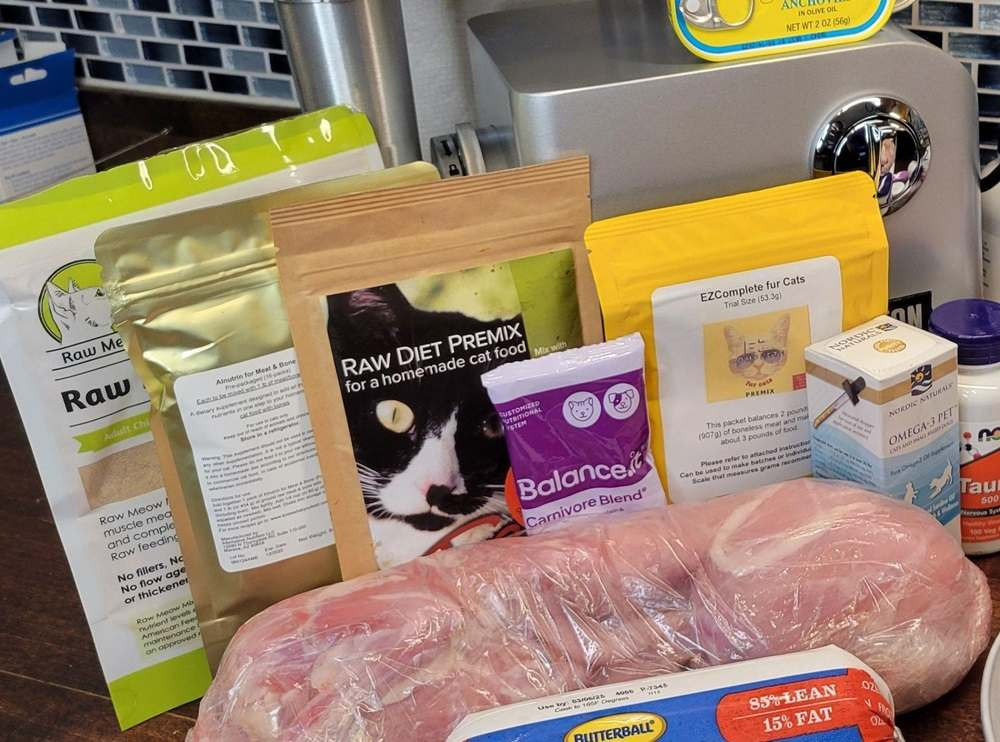 Premix Supplement
Premix Supplement
Creating a diet that mirrors a wild feline’s natural prey in perfect ratios of muscle meat, organs, and bone is complex. These diets often necessitate sourcing various animal proteins for both muscle meat and organs to prevent nutrient imbalances – both deficiencies and excesses.
For instance, liver from different animals varies in nutrient profiles. Duck and ruminant livers are richer in Vitamin A compared to chicken or pork liver. However, relying solely on chicken and pork liver might lead to copper deficiency.
To simplify the process and address these nutritional complexities, many cat owners turn to premix supplements, also known as meal completers, for their homemade cat food.
Premix supplements are specifically formulated to bridge nutritional gaps when combined with fresh meat. However, they are not a universal solution. Choosing the right premix still requires careful consideration and consultation with your veterinarian to ensure it aligns with your cat’s individual needs and your homemade diet plan.
Here are factors to consider when selecting a premix supplement:
Veterinary Nutritionist Formulation
While any licensed veterinarian has some training in animal health, specialized knowledge in nutrition is often limited. A premix formulated by a board-certified veterinary nutritionist offers a higher level of assurance regarding its nutritional soundness.
Complete and Balanced Nutrition Guarantee
Carefully examine the product labeling to determine if the premix is formulated to meet AAFCO or FEDIAF nutrient guidelines. Some premixes are designed only for supplemental feeding, while others may require the addition of ingredients like eggs or liver to achieve nutritional completeness.
Formulas for Specific Needs
Certain premix brands offer specialized formulas tailored to different life stages (kitten, adult, senior) or health conditions. For example, a senior cat formula might contain reduced phosphorus levels to support kidney health.
Diet Type Compatibility
Many premixes are designed for use with ground or chopped meat. These may contain higher calcium levels than premixes intended for diets incorporating ground meat and bone. Select a premix that is specifically formulated for the type of homemade diet you plan to feed.
5 Homemade Cat Food Recipes to Try (With Expert Guidance)
Below are five sample recipes to illustrate different approaches to homemade cat food. Some recipes utilize premix supplements for balanced nutrition, while others rely on ingredient variety and individual supplements. These recipes were compiled from online sources and premix manufacturer instructions and were tested for preparation.
Important Note: These recipes are examples and should be reviewed and adapted in consultation with a veterinary nutritionist to meet your cat’s specific needs.
1. Turkey Breast and Sweet Potato Recipe (using Balance It® Carnivore Blend® premix)
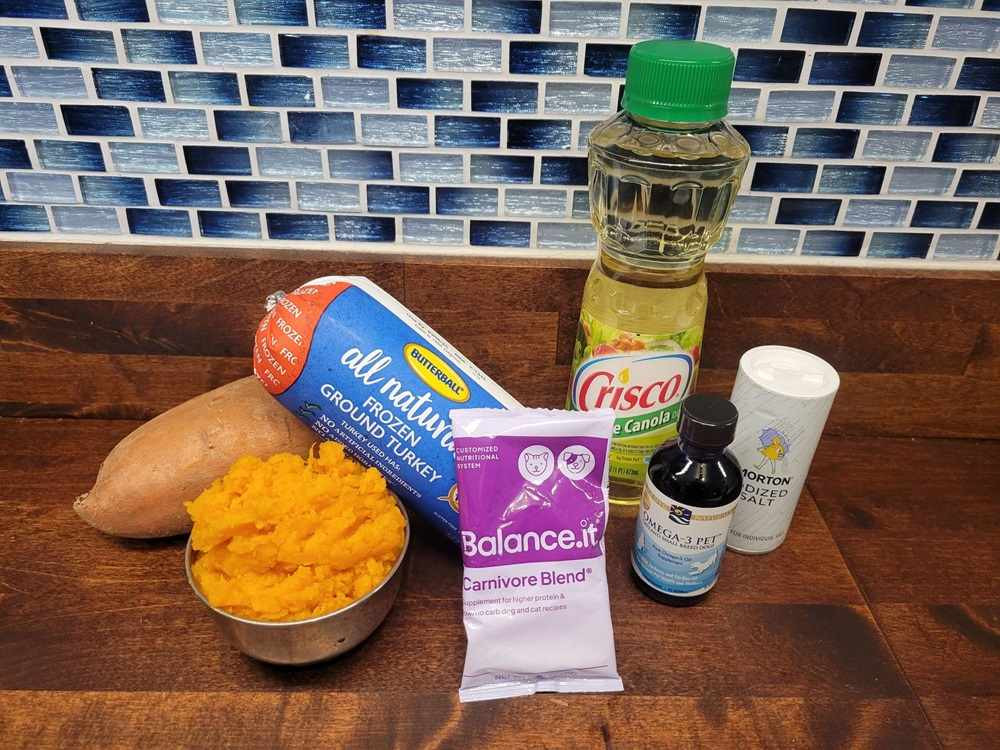 Turkey Breast and Sweet Potato Recipe
Turkey Breast and Sweet Potato Recipe
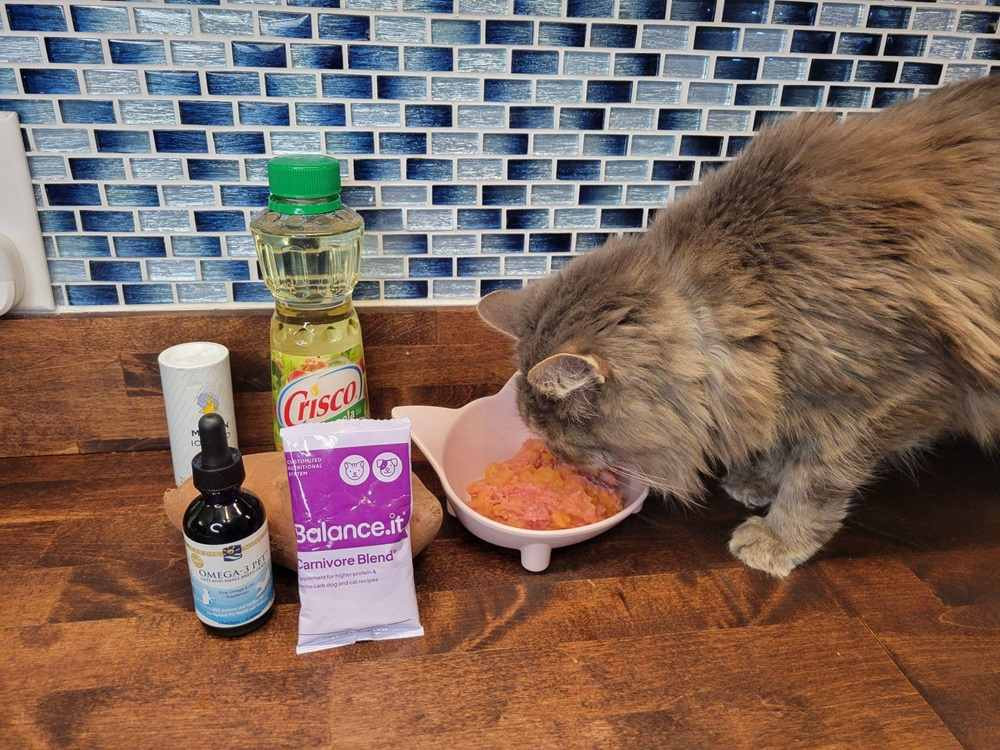 Turkey Breast and Sweet Potato Recipe with Balance It Premix
Turkey Breast and Sweet Potato Recipe with Balance It Premix
Balance.it is a reputable company specializing in homemade pet food solutions, founded by board-certified veterinary nutritionist Dr. Sean Delaney. They offer an online service to create custom pet food recipes using their premix powders.
This recipe, created using Balance.it’s recipe builder for a 10-pound, 5-year-old neutered male cat, is a high-protein, low-carb option, yielding approximately 170 grams of food with 265 calories.
Ingredients:
- 3 ⅜ oz. (96g) Cooked turkey breast (meat only)
- 1 ⅝ tsp (7g) Canola oil
- ⅖ ml (0.37g) Nordic Naturals Omega-3 Pet Liquid
- 5/16 cup (63g) Baked sweet potato
- ⅛ tsp (0.75g) Morton Iodized Salt
- ¾ tsp (3.07g) Balance IT Carnivore Blend
Instructions:
- Roast turkey breast at 350℉ until it reaches 165℉ internal temperature.
- Bake sweet potato alongside turkey until tender.
- Scoop sweet potato flesh from skin and weigh the required portion.
- Finely chop cooked turkey breast and weigh the required amount.
- Combine sweet potato and turkey in a mixing bowl.
- Add supplements and mix thoroughly.
- Divide into meal portions, serve one immediately.
- Store leftovers in an airtight container in the refrigerator.
Nutrient Content:
- Protein: 113.43g
- Fat: 36.79g
- Fiber: 7.78g
- Ash: 7.58g
- Carbs: 48.84g
Caloric Distribution:
- Protein: 47.73%
- Fat: 32.59%
- Carbs: 19.68%
- Moisture: 66.04%
Storage Note: Prepare larger batches of turkey and sweet potato, but add supplements just before serving to maintain freshness and nutrient integrity. Freeze portions for longer storage (3-4 days refrigerated).
2. Raw Ground Rabbit Recipe (using Alnutrin for Meat & Bone)
 Raw Ground Rabbit Recipe with Alnutrin
Raw Ground Rabbit Recipe with Alnutrin
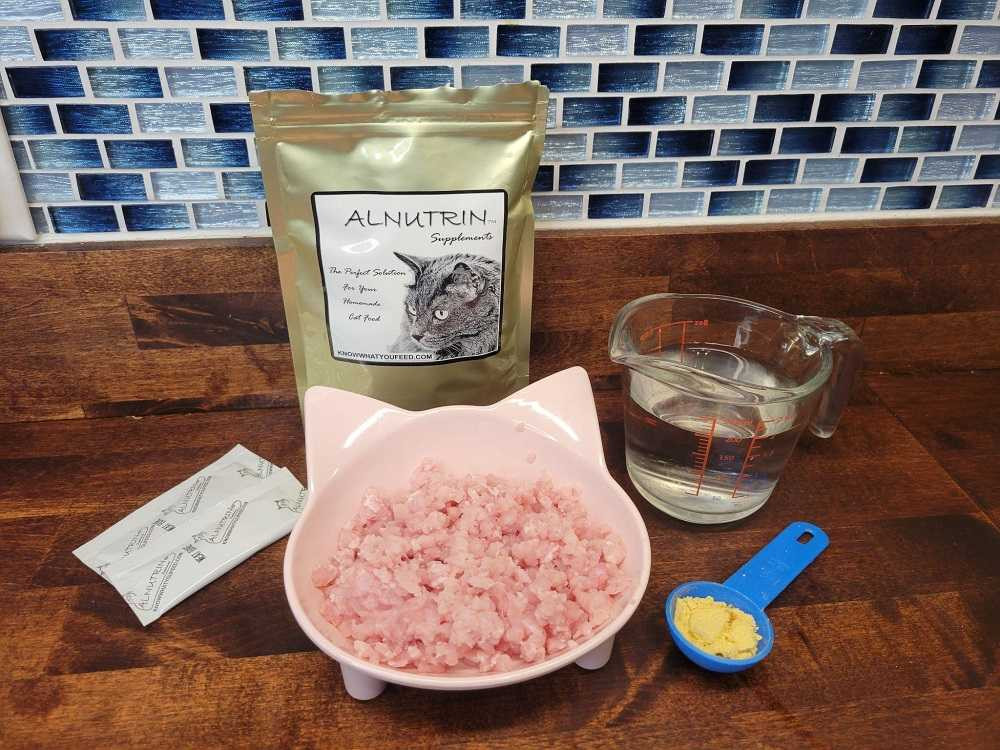 Raw Ground Rabbit Recipe
Raw Ground Rabbit Recipe
Alnutrin premix supplements, produced by Alternative Nutrition, LLC, are formulated to AAFCO nutrient profiles. Their “Meat & Bone” premix is designed for use with whole rabbit or chicken (including bone and organs).
This recipe utilizes Alnutrin’s “Meat & Bone” premix, suitable for cats with food sensitivities, as rabbit is often a novel protein source.
Ingredients:
- 1 pack (4g) Alnutrin for Meat & Bone
- ¼ cup (60g) Water
- 1 lbs (454g) Ground raw rabbit meat & bones
Instructions:
- Debone rabbit carcass, chop meat into 1-inch pieces.
- Chop or crush bones to grinder-safe size.
- Grind meat, bones, and organs into a bowl.
- Whisk Alnutrin and water in a small bowl.
- Stir premix mixture into ground rabbit, portion, and freeze.
Nutrient Content (Dry Matter):
- Protein: 65.3%
- Fat: 15.7%
- Fiber: NA
- Ash: 3.44%
- Carbs: 0%
Nutrient Analysis (As Fed, per 100g):
- Protein: 13.5g
- Fat: 3.24g
- Fiber: 0g
- Ash: 0.71g
- Moisture: 73g
Organ Note: Ensure whole rabbit includes organs. If not, source organs separately or use a different premix. Nutrient analyses are based on Alnutrin’s data using a whole dressed rabbit carcass.
3. Cooked Meat Recipe (using EZComplete Fur Cats)
 Cooked Meat Recipe with EZComplete Fur Cats
Cooked Meat Recipe with EZComplete Fur Cats
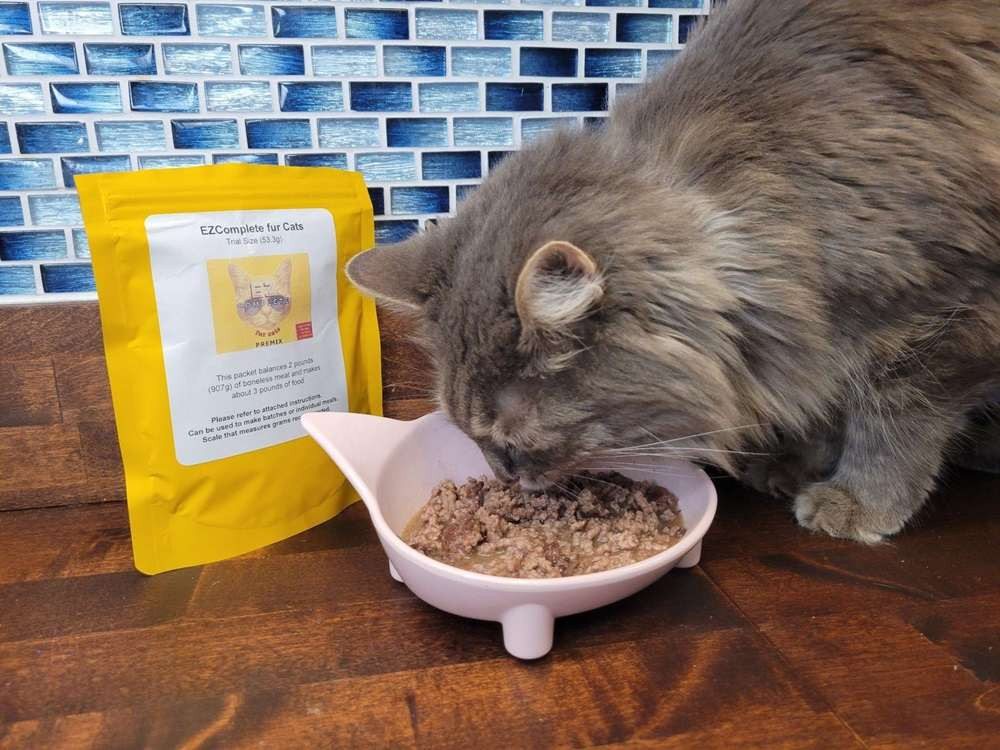 Cooked Meat Recipe
Cooked Meat Recipe
Food Fur Life produces EZComplete Premixes, made with human-grade ingredients in an FDA-inspected facility. EZComplete Fur Cats requires only boneless meat and water, and can be served raw or cooked.
This recipe uses EZComplete Fur Cats with cooked ground beef, a readily available protein source.
Ingredients:
- 2 lbs. (907g) Ground meat, cooked (lean proteins recommended)
- ½ cup (53.3g) EZComplete Fur Cats
- 1 ½ cups (12 oz.) Water
Instructions:
- Place ground meat in a slow cooker with ¼ cup water per pound of meat.
- Cook on low for 4-6 hours until meat is cooked through.
- Cool meat, shred or chop into bite-sized pieces.
- Stir in EZComplete until thoroughly mixed.
- Portion mixture, distributing cooking juices evenly.
- Refrigerate or freeze portions in airtight containers.
Nutrient Content (Dry Matter):
- Protein: 85%
- Fat: 11%
- Fiber: 0%
- Ash: 4%
- Carbs: 0%
Nutrient Note: Nutritional values are based on Food Fur Life’s analysis using EZComplete with turkey breast.
4. Prey Model Raw Diet Recipe (from Little Carnivore)
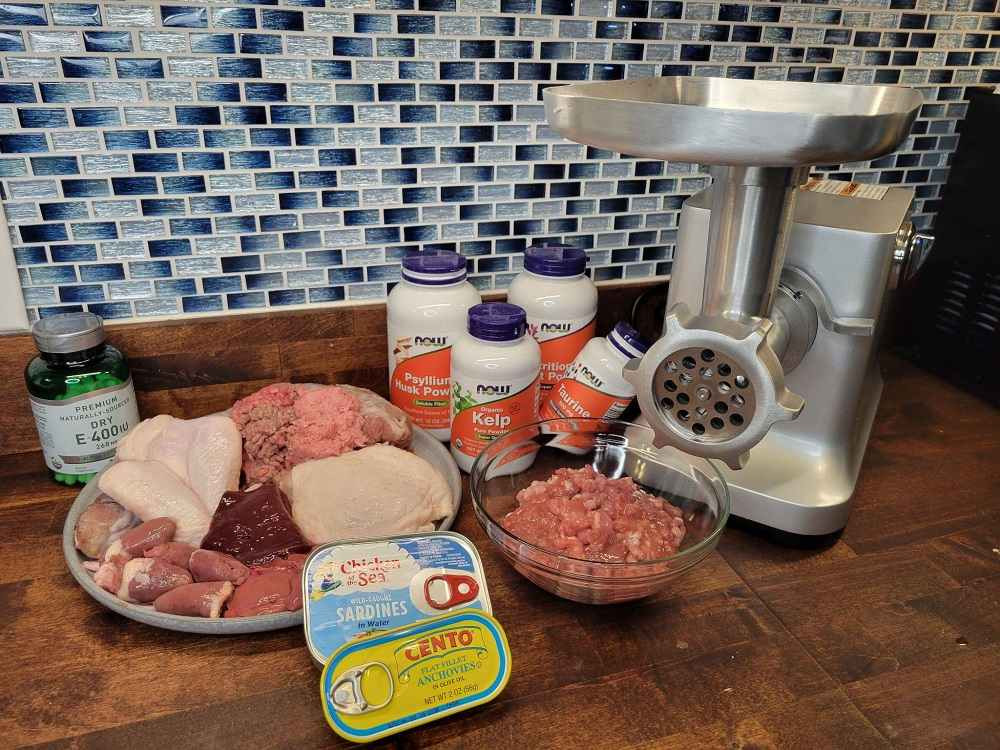 Prey Model Raw Diet Recipe from Little Carnivore
Prey Model Raw Diet Recipe from Little Carnivore
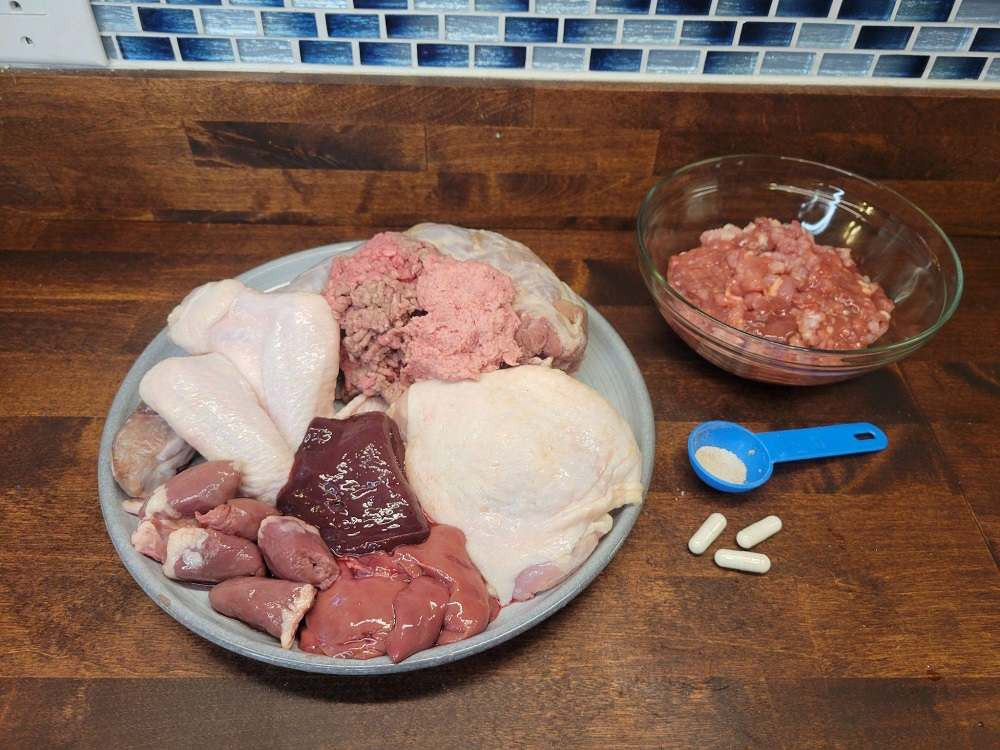 Prey Model Raw Diet Recipe
Prey Model Raw Diet Recipe
The Prey Model Raw (PMR) diet follows an 80/10/10 ratio: 80% meat, 10% bones, and 10% organs. PMR+ diets include supplements to ensure complete nutrition. Variety is crucial in PMR diets due to nutrient variations in different animal ingredients.
This recipe follows guidelines from feline nutritionist Coline Doebelin of The Little Carnivore. Ingredient ratios are calculated for a 1,000g batch.
Ingredients:
- 220g White meat (e.g., chicken, turkey, rabbit)
- 220g Red meat (e.g., beef, lamb, duck, veal)
- 100g Chicken hearts (or other heart)
- 100g Gizzards, tongue, or lung
- 100g Chicken, duck, or turkey neck
- 100g Chicken wings or quail bones
- 15g Chicken livers
- 15g Beef livers
- 70g Other organs (e.g., kidney, spleen, brain)
- 30g Whole sardines in water
- 30g Anchovies
Supplements:
- Chelated manganese
- Kelp powder (iodine)
- Psyllium husk (fiber)
- Vitamin E
- B-complex vitamins
- Calcium (optional)
- Zinc (optional)
- Taurine (optional)
- Iron (optional)
Instructions:
- Chop ingredients into 1-inch pieces, crush bones if needed for grinder.
- Grind ingredients together in ratio OR grind separately and weigh amounts.
- Use The Little Carnivore calculator for feeding amount and supplement dosages based on cat’s weight.
- Portion ground mixture and freeze in airtight containers.
- At mealtime, mix recommended supplements with thawed food before serving.
Nutrient Content (Dry Matter):
- Protein: 57.09%
- Fat: 30.3%
- Fiber: 0%
- Ash: 4.44%
- Carbs: 0.62%
Nutrient Analysis (As Fed, per 100g):
- Protein: 11.3g
- Fat: 6.2g
- Fiber: 0g
- Ash: 0.88g
- Carbs: 0.12g
Ingredient Note: Nutrient content varies; this is an estimate using primarily chicken, turkey, and beef. Review guidelines on The Little Carnivore and consult a vet or nutritionist to tailor this recipe.
5. Ground Chicken Thigh with Bone and Organs Recipe (from Feline Nutrition Foundation)
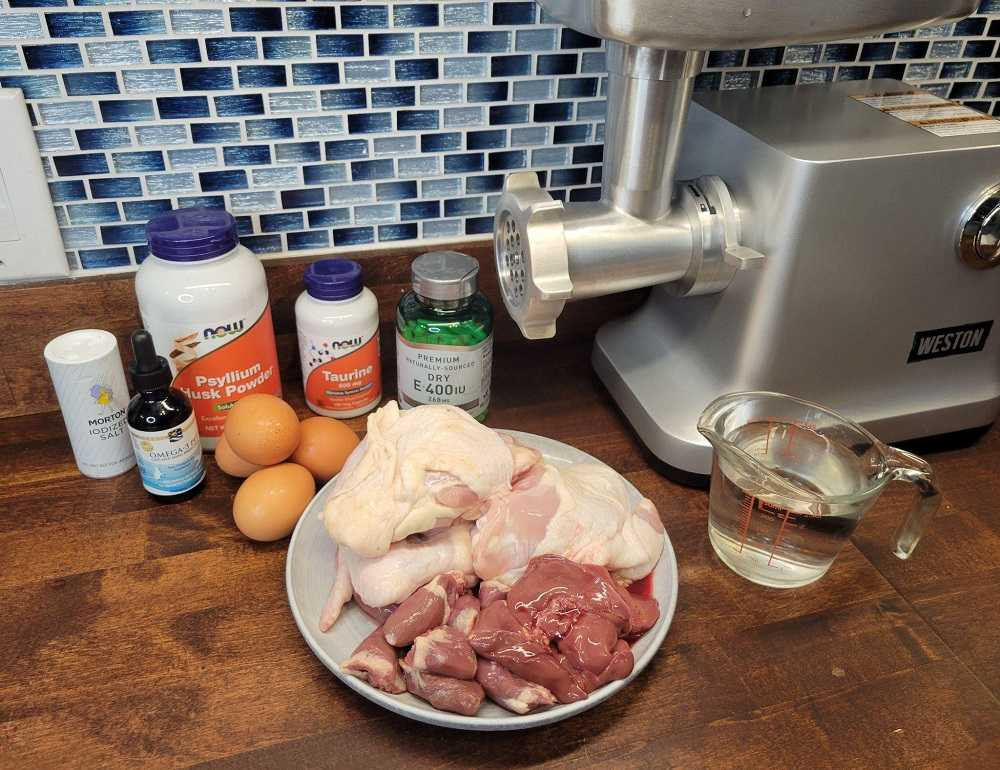 Ground Chicken Thigh with Bone and Organs Recipe from Feline Nutrition Foundation
Ground Chicken Thigh with Bone and Organs Recipe from Feline Nutrition Foundation
 Ground Chicken Thigh with Bone and Organs Recipe
Ground Chicken Thigh with Bone and Organs Recipe
This recipe, from the Feline Nutrition Foundation and recommended by raw diet brands like Hare Today, uses raw meat with bone, organs, and supplements. It requires more preparation but provides a nutritionally complete raw diet.
This recipe uses fresh chicken thighs, organs, egg yolks, and supplements.
Ingredients:
- 5 lbs. (2.27kg) Chicken thighs with skin and bone
- 7 oz (200g) Raw chicken liver
- 14 oz (400g) Raw chicken heart
- 8 oz. Water
- 4 Raw egg yolks
- 2000 mg Taurine
- 4000 mg Wild salmon oil capsules
- 200 mg Vitamin B Complex
- 200 IU Vitamin E
- 1 ½ tsp (8.4g) Lite Iodized Salt
- 4 tsp (8g) Psyllium husk powder
Instructions:
- Remove skin from half the chicken thighs and bone from 20-25%.
- Weigh 4.5 pounds of remaining chicken and rinse.
- Cut chicken and organs into 1-inch pieces, crush bones as much as possible.
- Grind animal ingredients and salmon oil capsules using a meat grinder.
- Whisk egg yolks and other supplements in a small bowl.
- Pour supplement mixture over ground ingredients and mix well.
- Portion mixture and freeze.
Nutrient Content (Dry Matter):
- Protein: 53.53%
- Fat: 33.06%
- Fiber: 0.81%
- Ash: 2.75%
- Carbs: 1.96%
Nutrient Analysis (As Fed, per 100g):
- Protein: 10.3g
- Fat: 6.36g
- Fiber: 0g
- Ash: 0.53g
Supplement Note: Use wild salmon oil capsules (or small fish oil capsules) instead of liquid, and dry powder supplements in capsules or loose powder. Avoid cod liver oil due to high Vitamin A.
Essential Supplies for Making Homemade Cat Food
For a homemade cat food diet, especially one based on ground meat and premixes, these supplies are highly recommended:
#1
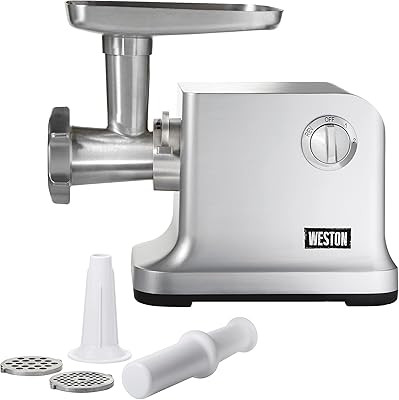 Weston Butcher Series Electric Meat Grinder
Weston Butcher Series Electric Meat Grinder
Weston Butcher Series Electric Meat Grinder Commercial Grade 1HP Motor
- Powerful 1HP motor for grinding meat and soft bones quickly.
- Economical price point around $200.
- Countertop-friendly size with two grinding speeds.
#2
Balance It Feline
- Formulated by a board-certified veterinary nutritionist.
- Offers multiple formulas for different life stages and health concerns.
- Includes an easy-to-use online recipe calculator.
#3
EZComplete fur Cats
- Formulated to meet AAFCO guidelines for complete nutrition.
- Made in the USA with human-grade ingredients.
- Requires only boneless meat and water for a complete meal.
#4
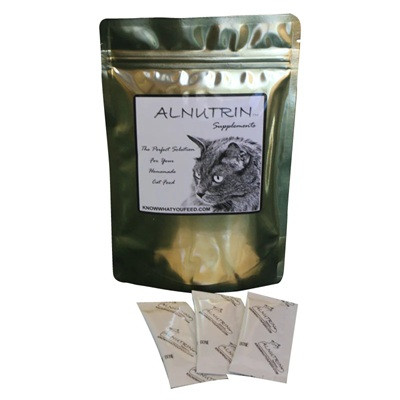 Alnutrin for Meat & Bone Premix
Alnutrin for Meat & Bone Premix
Alnutrin for Meat & Bone
- Formulated to meet AAFCO guidelines.
- Offers several premix products, including options for meat, bone, and liver diets.
- Provides free recipes on their website.
#5
TCfeline
- Formulated to meet AAFCO guidelines for all life stages.
- Made in the USA to mimic the nutritional profile of mice.
- Special low-phosphorus formula available for cats with kidney issues.
#6
Raw Meow Mix
- Formulated to meet AAFCO nutrient profile minimums.
- Made in Australia.
- Offers a broad range of options, including low-phosphorus and hypoallergenic formulas.
#7
Purrform
- Available in the UK and Europe.
- Likely formulated according to FEDIAF nutritional standards.
- Requires only boneless meat for a complete meal.
Frequently Asked Questions About Homemade Cat Food
Is homemade cat food safe for cats?
Commercial cat food undergoes processing to eliminate harmful pathogens. When preparing homemade cat food, especially raw diets, stringent hygiene practices are crucial for both your and your cat’s safety.
Safety Precautions for Raw Meat Handling:
- Thoroughly clean and disinfect all surfaces and utensils that come into contact with raw meat.
- Wash your hands meticulously after handling raw meat.
- Prevent your cat from licking your face after meals, particularly raw food meals.
- Supervise children to ensure they do not handle raw meat or allow the cat to lick their faces after eating.
When prepared and stored correctly, homemade cat food can be a safe and nutritious option.
How much does homemade cat food typically cost?
The cost of homemade cat food is variable, influenced by ingredient choices, the quantity you prepare, and whether you opt for raw or cooked recipes. Ingredient quality and sourcing will also impact the overall expense.
Is raw cat food nutritionally superior to cooked cat food?
Many animal nutritionists consider raw cat food to be more biologically appropriate for cats, aligning more closely with their natural diet. However, raw diets are not suitable for every cat owner. Raw meat can harbor bacteria like E. coli, posing a risk of foodborne illness. Research both raw and cooked options to determine the best approach for your cat and lifestyle.
What is the appropriate serving size of homemade cat food for my cat?
An average adult cat typically requires around 200 calories per day, equating to approximately 6 ounces of homemade food. Calorie density varies based on the protein and fat content of your chosen recipe. Consult with your veterinarian and utilize online calorie calculators to pinpoint your cat’s specific caloric needs and adjust portion sizes accordingly.

 Weston Logo
Weston Logo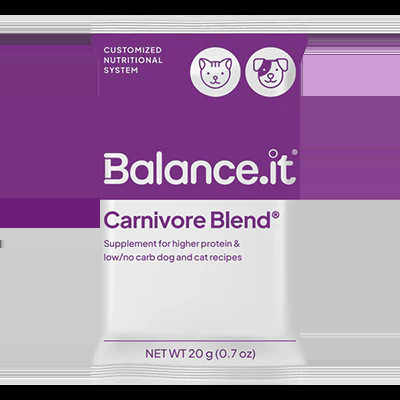 Balance It Feline Premix
Balance It Feline Premix EZComplete fur Cats Premix
EZComplete fur Cats Premix EZComplete Logo
EZComplete Logo Alnutrin Logo
Alnutrin Logo TCfeline Premix
TCfeline Premix TCfeline Logo
TCfeline Logo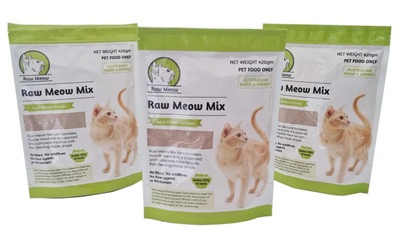 Raw Meow Mix Premix
Raw Meow Mix Premix Raw Meow Logo
Raw Meow Logo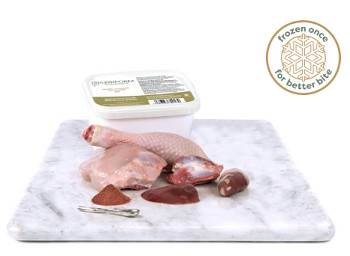 Purrform Premix
Purrform Premix Purrform Logo
Purrform Logo